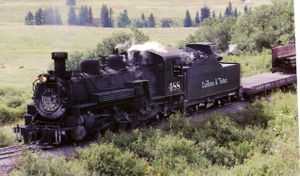D&RGW K-36
| Denver & Rio Grande Western K-36 class | |
|---|---|
|
K-36 #488 on the Cumbres and Toltec Scenic Railroad | |
| Type and origin | |
| References:[1] | |
| Power type | Steam |
| Builder | Baldwin Locomotive Works |
| Model | 12-34 1/4 E |
| Build date | 1925 |
| Total produced | 10 |
| Specifications | |
| Configuration | 2-8-2 |
| UIC classification | 1′D1′ h2 |
| Gauge | 3 ft (914 mm) |
| Driver diameter | 44 in (1,118 mm) |
| Locomotive weight | 187,100 lb (84.9 t) |
| Fuel type | Coal |
| Boiler pressure | 195 lbf/in2 (1.34 MPa) |
| Cylinders | Two |
| Cylinder size | 20 in × 24 in (508 mm × 610 mm) |
| Valve gear | Walschaerts |
| Performance figures | |
| Tractive effort | 36,200 lbf (161.03 kN) |
| Locomotive brake | S-6 (part of 6-ET schedule equipment) |
| Train brakes |
6-ET automatic air brakes on all. 480, 481, 482, 486 also have straight air equipment. All delivered with G-6 equipment new. |
| Career | |
| Operator(s) | |
| Number(s) | 480–489 |
| Locale | Colorado and New Mexico |
| Disposition | One (485) scrapped,remainder operational or preserved |
The Denver and Rio Grande Western K-36 class are ten 3 ft (914 mm) narrow gauge, Mikado type, 2-8-2 steam locomotives built for the Denver and Rio Grande Western Railroad (DRGW) by Baldwin Locomotive Works. They were shipped to the Rio Grande in 1925, and were first used along the Monarch Branch and Marshall Pass, but were later sent to the Third Division out of Alamosa. Of the original ten, four are owned by the Durango and Silverton Narrow Gauge Railroad (D&SNG) and five by the Cumbres and Toltec Scenic Railroad (C&TS). Number 485 fell into the turntable pit at Salida and was scrapped in Pueblo in 1955, with many parts being saved.
The locomotives are of outside-frame design, with the driving wheels placed between the two chassis frames which support the boiler, but with the cylinders, driving rods, counterweights and valve gear on the outside. This general arrangement is shared with the earlier K-27, K-28 and later K-37 Mikado engines.
The Name
The locomotives' name of K-36 comes from two different sources. The K in the name comes from the locomotives' wheel arrangement (Mikado), and the 36 stands for 36,200 pounds of tractive effort.
In Service
The K-36s were used primarily as freight locomotives out of Alamosa to Durango, and to Farmington, New Mexico, as well as out of Salida to Gunnison (over Marshall Pass) until 1955 and to Monarch on the Monarch Branch until 1956. They were built with special valves to allow brake control between locomotives while double-heading, and were commonly found between Alamosa and Chama, New Mexico. They were heavily used during the pipe boom in Farmington, and hauled long freight trains between Alamosa and Farmington.
Roster[2][3]
| Number | Photo | Builder's Number |
Current Owner |
Notes |
|---|---|---|---|---|
| 480 |  |
58558 | D&SNG | Retired 1970 to D&SNG 3/1981 |
| 481 | 58559 | D&SNG | To D&SNG 3/1981 First K-36 run to Silverton | |
| 482 |  |
58541 | D&SNG | Retired 1962 to C&TS 1970 to D&SNG 1991 |
| 483 |  |
58584 | C&TS | To C&TS 1970 |
| 484 |  |
58585 | C&TS | To C&TS 1970 |
| 485 |  |
58586 | Dismantled 1/24/1955 | |
| 486 |  |
58587 | D&SNG | Retired 1962 to Royal Gorge for display, 12/1967 to D&SNG, 1999 |
| 487 |  |
58588 | C&TS | To C&TS 1970 |
| 488 |  |
58589 | C&TS | To C&TS 1970 |
| 489 | 58590 | C&TS | Retired 1962 to C&TS 1970 K-36 489 | |
References
- ↑ "Denver & Rio Grande Western Mikados". Steam Locomotive dot com. Retrieved 12 February 2010.
- ↑ "Denver & Rio Grande Western Roster". Rio Grande Modeling & Historical Society. Retrieved 12 February 2010.
- ↑ "Durango & Silverton Steam". DRGW.net. Retrieved 12 February 2010.
| Wikimedia Commons has media related to Denver and Rio Grande Western K-36 class. |